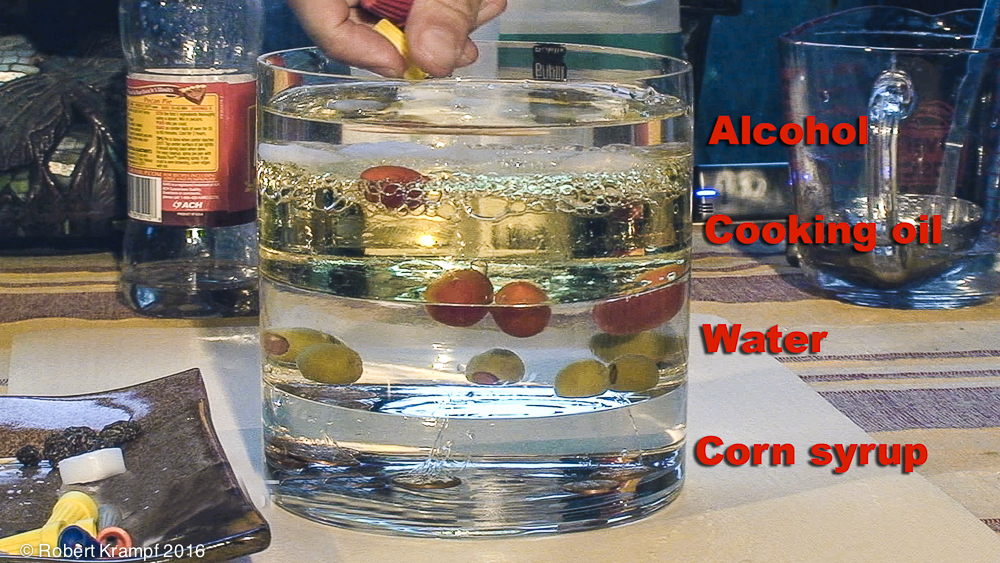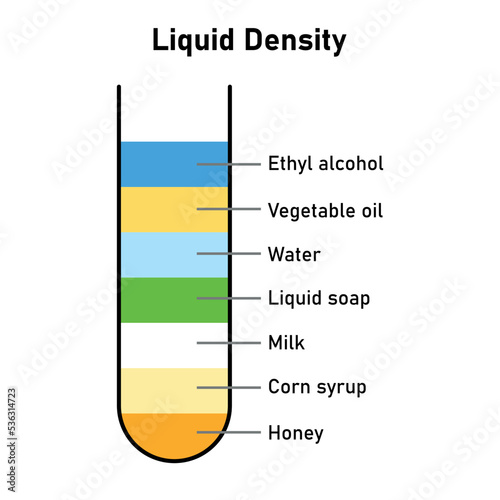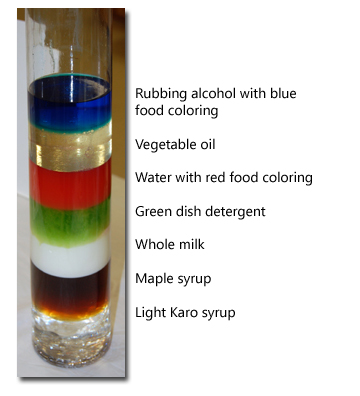Corn syrup has a density of approximately 1.37 grams per cubic centimeter. This makes it denser than water.
Corn syrup is a popular sweetener in many food products. It is derived from corn starch through a process called hydrolysis. This thick, viscous liquid adds sweetness, moisture, and texture to various dishes and baked goods. Due to its high density, corn syrup is heavier and thicker than many other liquid sweeteners.
Its unique properties make it a versatile ingredient in both commercial and home kitchens. Corn syrup is often used in candies, sauces, and beverages, enhancing flavor and stability. Understanding its density and characteristics can help you use it effectively in cooking and baking.

Credit: www.thehappyscientist.com
Corn Syrup Composition
Corn syrup is a common sweetener in many foods. Its composition affects its density. Understanding its ingredients and chemical structure helps us know why.
Ingredients
Corn syrup is made from corn starch. Corn starch is broken down into glucose. Glucose is a type of sugar.
Ingredients in corn syrup include:
- Corn starch
- Water
- Enzymes
These ingredients work together to create a sweet, thick liquid.
Chemical Structure
Corn syrup’s chemical structure is simple. It is mainly glucose molecules. These molecules are small and uniform.
Glucose molecules link together. This makes the syrup thick. The more glucose, the denser the syrup.
Corn syrup has a high density because of its glucose content. Its thickness makes it useful in many recipes.

Credit: stock.adobe.com
Measuring Density
Understanding the density of corn syrup is crucial in various applications. Density tells us how much mass is packed into a given volume. This section explores different methods and units for measuring the density of corn syrup.
Methods
Several methods exist to measure the density of corn syrup. One common method is using a hydrometer. A hydrometer is a device that floats in the liquid, and the level at which it floats indicates the density.
Another method is the pycnometer. A pycnometer is a specialized flask used to measure the density of liquids. You fill it with corn syrup and weigh it. This method gives a precise measurement.
The digital density meter is another tool. It measures density by calculating the time it takes for a vibrating tube to oscillate when filled with the liquid. This method is quick and accurate.
Units
Density is usually expressed in grams per cubic centimeter (g/cm³). This unit tells us how many grams of corn syrup are in one cubic centimeter.
In some cases, density is measured in kilograms per liter (kg/L). One kg/L is equivalent to one g/cm³. This unit is often used in larger industrial applications.
Another unit is pounds per gallon (lb/gal), commonly used in the United States. This unit helps in understanding the density in terms of weight per volume.
| Method | Description |
|---|---|
| Hydrometer | Floats in the liquid to measure density |
| Pycnometer | Specialized flask for precise measurements |
| Digital Density Meter | Calculates density using vibrating tube |
| Unit | Description |
|---|---|
| g/cm³ | Grams per cubic centimeter |
| kg/L | Kilograms per liter |
| lb/gal | Pounds per gallon |
Viscosity Factors
Corn syrup’s viscosity can change due to various factors. Understanding these factors helps in using corn syrup effectively in recipes. This section will explore how temperature and concentration levels affect the viscosity of corn syrup.
Temperature Influence
Temperature plays a major role in the viscosity of corn syrup. When the temperature increases, the syrup becomes less viscous. This means it flows more easily. Conversely, at lower temperatures, corn syrup thickens. It becomes harder to pour and mix.
Here’s a simple table to illustrate:
| Temperature (°C) | Viscosity (Pa.s) |
|---|---|
| 0 | 5.0 |
| 20 | 2.5 |
| 40 | 1.2 |
| 60 | 0.8 |
Concentration Levels
The concentration of corn syrup also affects its viscosity. Higher concentrations mean more sugar content. This makes the syrup thicker. Lower concentrations, with more water, result in a thinner syrup.
Here are some points to consider:
- High Concentration: Thick, sticky, harder to stir.
- Low Concentration: Thin, easier to pour and mix.
To sum up, both temperature and concentration levels play crucial roles. Adjust these factors to achieve the desired viscosity of corn syrup in your recipes.
Practical Applications
Corn syrup is a common ingredient in many households. Its density gives it unique properties that make it useful in several fields. Let’s explore how the density of corn syrup plays a role in different applications.
Food Industry
Corn syrup is widely used in the food industry. Its high density makes it an excellent sweetener and thickener.
Here are some practical uses in the food industry:
- Baked Goods: Corn syrup helps retain moisture in cakes and cookies.
- Beverages: It sweetens soft drinks and keeps them smooth.
- Candies: Corn syrup prevents sugar crystallization in candies.
The table below summarizes the main applications:
| Application | Benefit |
|---|---|
| Baked Goods | Moisture retention |
| Beverages | Smooth texture |
| Candies | Prevents crystallization |
Non-food Uses
Corn syrup’s density makes it useful outside the kitchen too. Here are some non-food applications:
- Medical Field: Corn syrup is used in some medicines as a thickener.
- Crafts: It can be used in slime-making for kids.
- Science Experiments: Corn syrup is often used in density experiments.
These non-food uses leverage its unique properties for various practical applications.
Comparisons With Other Syrups
Understanding the density of corn syrup involves comparing it with other syrups. These comparisons help highlight its unique characteristics. Let’s delve into how corn syrup stacks up against maple syrup and honey.
Maple Syrup
Corn syrup and maple syrup are popular sweeteners. Both have different densities.
Here is a table to compare their densities:
| Syrup Type | Density (g/mL) |
|---|---|
| Corn Syrup | 1.36 |
| Maple Syrup | 1.33 |
As seen in the table, corn syrup is slightly denser than maple syrup. This slight difference can affect recipes and textures.
Honey
Honey is another natural sweetener. It has a different density compared to corn syrup.
Here is a table to compare their densities:
| Syrup Type | Density (g/mL) |
|---|---|
| Corn Syrup | 1.36 |
| Honey | 1.42 |
Honey is denser than corn syrup. This makes it thicker and more viscous.
Comparing these syrups helps understand their unique properties. This can be important for cooking and baking.

Credit: www.esr.org
Frequently Asked Questions
What Is The Density Of Corn Syrup?
Corn syrup has a density of approximately 1. 4 grams per cubic centimeter.
How Does Corn Syrup Density Compare To Water?
Corn syrup is denser than water, which has a density of 1 gram per cubic centimeter.
Why Is Corn Syrup So Dense?
Corn syrup is dense because it contains a high concentration of dissolved sugars and other carbohydrates.
Does Temperature Affect Corn Syrup Density?
Yes, temperature changes can slightly affect the density of corn syrup, making it less dense when heated.
Is Corn Syrup Denser Than Honey?
Yes, corn syrup is generally denser than honey, which has a density around 1. 36 grams per cubic centimeter.
Can Corn Syrup’s Density Be Measured At Home?
Yes, you can measure corn syrup’s density using a kitchen scale and a graduated cylinder.
Conclusion
Understanding the density of corn syrup helps in various culinary and industrial applications. Its thick consistency makes it a versatile ingredient. Knowing its properties can improve your cooking and manufacturing outcomes. Explore and experiment with corn syrup to achieve the best results in your recipes and projects.
